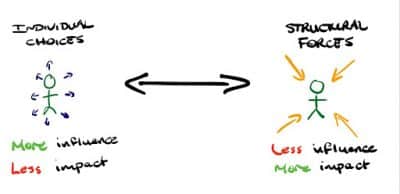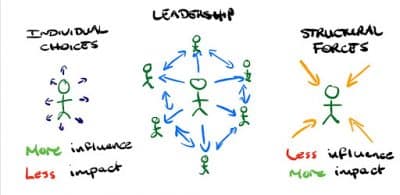
From Impotence to Influence
29th Sep 2022
If you’re like me, you might sometimes feel a little overwhelmed when you think about the state of the world. It’s kind of terrifying if you think too much about it.
And if you’re like me, you care about contributing to making the world a better place. But how much can one individual do?
I’ve just finished reading Stolen Focus: Why You Can’t Pay Attention. It’s a brilliant book, yet it’s not a self-help book with hacks to help you focus. The author is at pains to point out that there are massive structural forces at play – social media companies, our food system, environmental pollution to name a few – that are geared in ways that make it difficult for us to pay attention. As much as we might try, life hacks won’t cut it. Yet he also says that to solve our societal issues, we need to be able to think clearly and have deep conversations, both of which require the ability to focus. I’ve finished the book feeling both inspired and impotent. What to do?
It’s easy to feel impotent when we care about making change happen, and at the same time we have this gnawing sense that there’s little we can do on our own.
There’s a tension at play, and it looks like this:

On the left is what we can do as individuals to change our own circumstances. For me, as I research what it takes to be more unhurriedly productive, I’m learning great life hacks to help me slow down and still make good things happen. Client-free Fridays, learning to say ‘no’, and being kind to my future self all fit in here. I have lots of control over these choices, but they’re probably not going to make much impact at scale.
On the right is what dictates the context we find ourselves: the big structural forces. For example, with unhurried productivity, one of the major structural forces is our relentless focus on economic (GDP) growth. The assumption that we need to collectively create and consume more every year drives a hurriedness from the centre that affects all of us. I have way less control over changing this, yet if it did change it would have a massive impact on so many peoples’ wellbeing.
When you look at the two poles – individual choices and structural forces – it can feel like there’s a massive chasm between them.
If we’re to be effective, we need a bridge.
What’s the bridge look like?
It’s leadership. And it looks like this:

Leadership begins when we go beyond a focus on ourselves, and we bring together others who care about the same thing. It’s a shift from ‘attention in’ to ‘attention out’, away from yourself and onto a higher purpose. It’s the shift from ‘I can and others should’ to ‘We can and others can too’. It’s learning to influence, learning to empower, learning to lead.
If you care about changing the game you’re in, develop a discipline that keeps you ‘individually choiceful’ about your own wellbeing. And then learn to lead.
Start small, and start today. Here are some questions to help you:
- Beyond your own wellbeing, what do you most want for your world?
- What makes you angry?
- What lights you up?
- Who around you also cares about this stuff?
- How might you invite them into a conversation?
Like this post? When you’re ready, here are three ways I can help you further:
- Sign up to my ‘Thinking from the Edge’ newsletter to get tips, insights and early release information that I don’t share on the usual social channels. Delivered weekly to your inbox.
- Get my book, Change Makers: How to make your mark with more impact and less drama. It’s available here.
- Check out Change Makers– a programme + community to help you make your mark with more impact and less drama.

